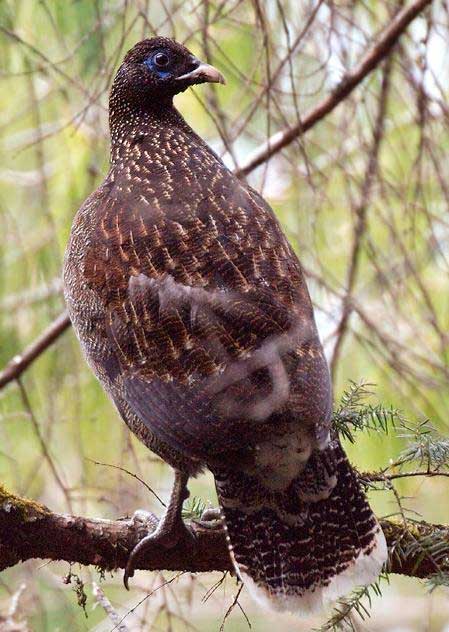Lophophorus sclateri (*) Cladus: Eukaryota Name Lophophorus sclateri Jerdon, 1870 Reference Ibis p.148 Vernacular names Sclater's Monal, Lophophorus sclateri, also known as the Crestless Monal, is a large, approximately 68 centimetres (27 in) long, pheasant of the east Himalayan region. As other monals, the male is a colorful bird. It has a highly iridescent purplish-green upperparts plumage, short and curly metallic green crown feathers, copper neck, purplish-black throat, white back, blue orbital skin, yellowish-orange bill and brown iris. In the nominate subspecies, the tail is white with a broad chestnut band, while the tail is entirely white in L. s. arunachalensis from western Arunachal Pradesh in India.[2] The crestless female is mostly a dark brown bird with a white throat and tail-tip, dull bluish orbital skin and a pale yellow bill. Sclater's Monal is distributed to mountain forests of southeast China, northern Burma and northeast India, at altitudes of 2,500 to 4,200 metres (8,200 to 13,800 ft). The diet of the Sclater's Monal is like that of other members of the genus Lophophorus, probably consists mainly of tubers, roots, bulbs, arthropods, rodents, seeds and flowers. The female usually lays between three to five eggs. The male Himalayan Monal guards the nest and helps rear the chicks. It is not known if the Sclater's Monal male participates in nest defense but it is likely. The name commemorates the British zoologist Philip Lutley Sclater. Due to ongoing habitat loss, small population size, limited range and overhunting in some areas for food and its feathers, Sclater's Monal is evaluated as Vulnerable on IUCN Red List of Threatened Species. It is listed on Appendix I of CITES. 1. ^ BirdLife International (2004). Lophophorus sclateri. 2006. IUCN Red List of Threatened Species. IUCN 2006. www.iucnredlist.org. Retrieved on 25 November 2006. Database entry includes a brief justification of why this species is vulnerable and the criteria used Source: Wikipedia, Wikispecies: All text is available under the terms of the GNU Free Documentation License |
|

